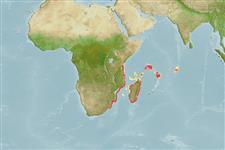Élasmobranches (requins et raies) (sharks and rays) >
Carcharhiniformes (Ground sharks) >
Proscylliidae (Finback catsharks)
Etymology: Eridacnis: Etymology not explained, possibly eri-, Greek intensive particle (i.e., very), and dakno (Gr.), bite, referring to “wide, angular” mouth of E. radcliffei. (See ETYFish); sinuans: Latin for sinuous, probably referring to its slender body and/or long, ribbon-like caudal fin. (See ETYFish).
More on author: Smith.
Environment: milieu / climate zone / depth range / distribution range
Écologie
marin bathydémersal; profondeur 180 - 480 m (Ref. 244). Deep-water; 4°S - 30°S
Western Indian Ocean: confined to South Africa, Mozambique and Tanzania.
Length at first maturity / Taille / Poids / Âge
Maturity: Lm ?, range 37 - ? cm
Max length : 37.0 cm TL (female)
Description synthétique
Morphologie | Morphométrie
Épines dorsales (Total): 0; Rayons mous dorsaux (Total): 0; Épines anales 0; Rayons mous anaux: 0. A slender, dwarf catshark with 2 equal-sized dorsal fins and a long tape-like caudal fin (Ref. 5578). Grey-brown in color (Ref. 5578).
Found on the upper continental slope and outer shelf (Ref. 244). Feeds on small bony fishes, crustaceans and cephalopods (Ref. 244). Ovoviviparous (Ref. 50449), with 2 young in a litter (Ref. 244). Geographic or bathymetric segregation of populations by sex probably occurs as most specimens taken off Natal were male (Ref. 244).
Ovoviviparous, embryos feed solely on yolk (Ref. 50449). Bears two young (Ref. 5578). Size at birth between 15 and 17 cm (Ref. 244).
Compagno, L.J.V., 1984. FAO Species Catalogue. Vol. 4. Sharks of the world. An annotated and illustrated catalogue of shark species known to date. Part 2 - Carcharhiniformes. FAO Fish. Synop. 125(4/2):251-655. Rome: FAO. (Ref. 244)
Statut dans la liste rouge de l'IUCN (Ref. 130435)
Utilisations par l'homme
Pêcheries: sans intérêt
Plus d'informations
Taille/ÂgeCroissanceLongueur-poidsLongueur-longueurFréquences de longueursMorphométrieMorphologieLarvesDynamique des populations larvairesRecrutementAbondanceBRUVS
RéférencesAquacultureProfil d'aquacultureSouchesGénétiqueElectrophoresesHéritabilitéPathologiesTraitementNutrientsMass conversion
CollaborateursImagesStamps, Coins Misc.SonsCiguateraVitesseType de nageSurface branchialeOtolithesCerveauxVision
Outils
Articles particuliers
Télécharger en XML
Sources Internet
Estimates based on models
Preferred temperature (Ref.
123201): 12.8 - 18.4, mean 15.3 °C (based on 18 cells).
Phylogenetic diversity index (Ref.
82804): PD
50 = 0.6328 [Uniqueness, from 0.5 = low to 2.0 = high].
Bayesian length-weight: a=0.00389 (0.00180 - 0.00842), b=3.12 (2.94 - 3.30), in cm total length, based on all LWR estimates for this body shape (Ref.
93245).
Niveau trophique (Ref.
69278): 4.2 ±0.58 se; based on food items.
Résilience (Ref.
120179): Très faible, temps minimum de doublement de population supérieur à 14 ans (Fec=2).
Fishing Vulnerability (Ref.
59153): Low to moderate vulnerability (27 of 100).
